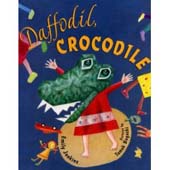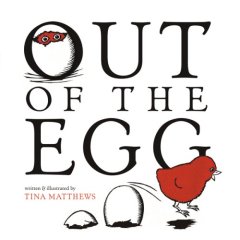Picture Book Round-Up: Got Meek? Not Daffodil
(Plus, the Little Red Hen Redux and More)
 May 24th, 2007 by jules
May 24th, 2007 by jules
Yeesh, that’s a particularly painful post title, but my creativity is put to the test with each new picture book round-up. Let’s just forget it and get right to the books then . . .

Written by Emily Jenkins
and illustrated by Tomek Bogacki
Farrar, Straus and Giroux
(Books for Young Readers)
April 2007
(library copy)
Here’s to a determined advancement of one’s own views as only Emily Jenkins can tell it; make way (again) for Daffodil! As you may recall from the 2004 title, Daffodil is one of three sisters who all look alike and who all have rather florid names (Violet and Rose are her sisters). Even their poor mother sometimes can’t tell the girls apart. Always charming those they meet, without even meaning to (“They’re such NICE little girls . . . So clean. So pretty. So quiet. Like a bouquet of flowers”), Daffodil gets a bit fed up with being mistaken for her sisters, even in school, and with all the rather condescending, cutesy attention paid to her. One day she takes the papier mâché project her mother is creating, a crocodile head that fits just perfectly, and wears it around. “I like it! . . . Crocodiles are not flowers . . . Raaa raaa raaa Chomp chomp chomp,” she tells her sisters. She then proceeds to have adventures in it, eating the guests at her sisters’ tea party and sticking green beans up its nose at dinner. “‘Where’s my pretty little, clean little flower?’ Mommy asked” to which Daffodil replies, “I ate her” . . . Eventually, the papier mâché head ruins, but she realizes she can still channel her inner assertor without the reptilian mug. The Horn Book review writes, “{l}ike Max’s wolf suit, the crocodile head . . . helps free the wilder side within; in devouring one self, Daffodil releases another . . .” As she lets loose her fantasies of becoming a scary, aggressive monster and, for once, isn’t seen as a diminutive, showpiece of a flower, one can’t help but think of Sendakian themes, in terms of children facing their fears. But it’s still a story all of Jenkins’ own, and Bogacki’s colorful, textured illustrations complement the story perfectly, particularly with the transition from rosy-cheeked Daffodil to the oversized crocodile head, drawing focus whenever it appears. Welcome back, Daffodil . . .
by Tina Matthews
Houghton Mifflin
March 2007
(library copy)
As Roger Sutton put it, this story is “more than a little adult in theme, but . . . all on the side of the young.” Tina Matthews takes the traditional folk tale, “The Little Red Hen,” and provides a new twist on St. Augustine’s plea to be forgiven for the sins of the mother. “One day a Red Hen found a green seed.” The Fat Cat, the Dirty Rat, and the Greedy Pig — who, when we first see them, are displaying their best couch-potato moves (or, uh, a lack thereof) in front of the TV — all refuse to help her plant the seed, water the seedling, dig up the weeds around it, and shelter what becomes a big, sturdy tree from the wind and rain. Years go by, and she lays “a perfect white egg” under said tree. Out pops a little red chick who grows into a determined young one who can form her own opinions, aw snap snap. When the progeny of the Fat Cat, Dirty Rat, and Greedy Pig arrive to ask who will let them play under the tree where the chick was hatched, Red Hen says, with a certain amount of well-deserved bitterness, “Not I!” to which the chick replies, “Mum, that’s MEAN!” The young animals play together, and Red Hen sends them on their way home with a fitting gift on the final page of the book (Matthews even giving us a glimpse of the now-middle-aged cat, rat, and pig parents, still being lazy on a front porch). Matthews’ Japanese woodblock prints, printed by hand, are rendered in black but with eye-catching red for Red Hen and her chick and green for the tree, opening with mostly black, littered landscapes and ending with a great deal more green and less trash. Matthews seems to be providing subtle commentary in an environmental vein with these choices, fitting nicely with the final page’s words and the message it conveys. An aesthetically-pleasing little joy.

by Barbara Kerley
National Geographic
May 2007
(copy from author)
“All it takes is . . . one hand/ One smile/ A single voice . . .” Barbara Kerley brings us another eye-popping National Geographic title, this time with her rhythmic text about how spreading peace starts with one person reaching out to another. The vibrant, glossy National Geographic photos are of children holding hands in New Mexico; an Ohio girl sounding her own barbaric yawp in the name of freedom of speech; men praying in a mosque in India; choir members singing and clapping in a Louisiana church damaged during Hurricane Katrina; a doctor from the U.S. Marine Corps comforting an Iraqi boy in the midst of war; and much more, all conveying varying messages of the idea that we all, no matter where we live, share a desire for peace and manifest it in a multitude of ways. This. couldn’t. be. a. timelier. message. In fact, as Barbara shared with us in our April interview, she was partly inspired to write this in 2002 after her then-6th-grade daughter told her that boys in school would claim that they hope the war with Iraq is still ongoing when they’re adults so that they can “kick some butt.” As with her previous National Geographic titles, a final spread names the cities and countries featured in each photo. The “Note on Peace” at the book’s close from peace negotiator and President of the United States Institute of Peace, Richard H. Solomon, is almost superfluous, since Kerley’s thoughtful text and the splendid photographs already say it all so well. A great title for discussion for students of all ages.

A Child’s Book of Time
Written by Hazel Hutchins
and illustrated by Kady MacDonald Denton
Arthur A. Levine Books
March 2007
(library copy)
Take the nebulous and abstract concept of time and explain it using entertaining, child-centered analogies, and you’ve got this fetching title from Hazel Hutchins and Kady MacDonald Denton, sub-titled A Child’s Book of Time and written in rhyming text. “How long is a second?” it opens. “A second is a hiccup — The time it takes to kiss your mom/ Or jump a rope/ Or turn around.” Moving on to minutes and continuing with hours, days, weeks, months, and years, Hutchins packs each rhyme with tremendous child appeal, including verses about building sand-castles and running through a sprinkly shower (you can do that in an hour); falling and scraping a shin (“{i}n a month there’s brand-new skin”); and growing right out of old shoes along with the “{h}olidays of every kind / Linked together in a line / When your birthday’s almost here, / You are older / By a year!” Denton’s breezy watercolor illustrations are full of cheer and many details to see and discuss. She often will give you a bold, beautiful splash of color (that still manages not to overwhelm a composition) where you least expect it (a father playing banjo for his son but with a vibrant blue surrounding him to bring focus); there couldn’t possibly be a better match for Hutchins’ text. Coming around full-circle on the final page with “{a} second is a hiccup,” it makes for an enjoyable trip around a year, stopping to note all the time markers within in a way that will fascinate young children.


Okay, this may be my favorite round-up yet, ’cause I haven’t seen any of these in person yet. They all look great. And can I just tell you how much I love Katy MacDonald Denton? Would They Love a Lion? is one of my all-time faves.
Eisha, I’ve never seen that Lion title. Will have to look for it. LOVE her illustrations in A Second is a Hiccup. The entire book has a very Ruth Krauss feel to it.